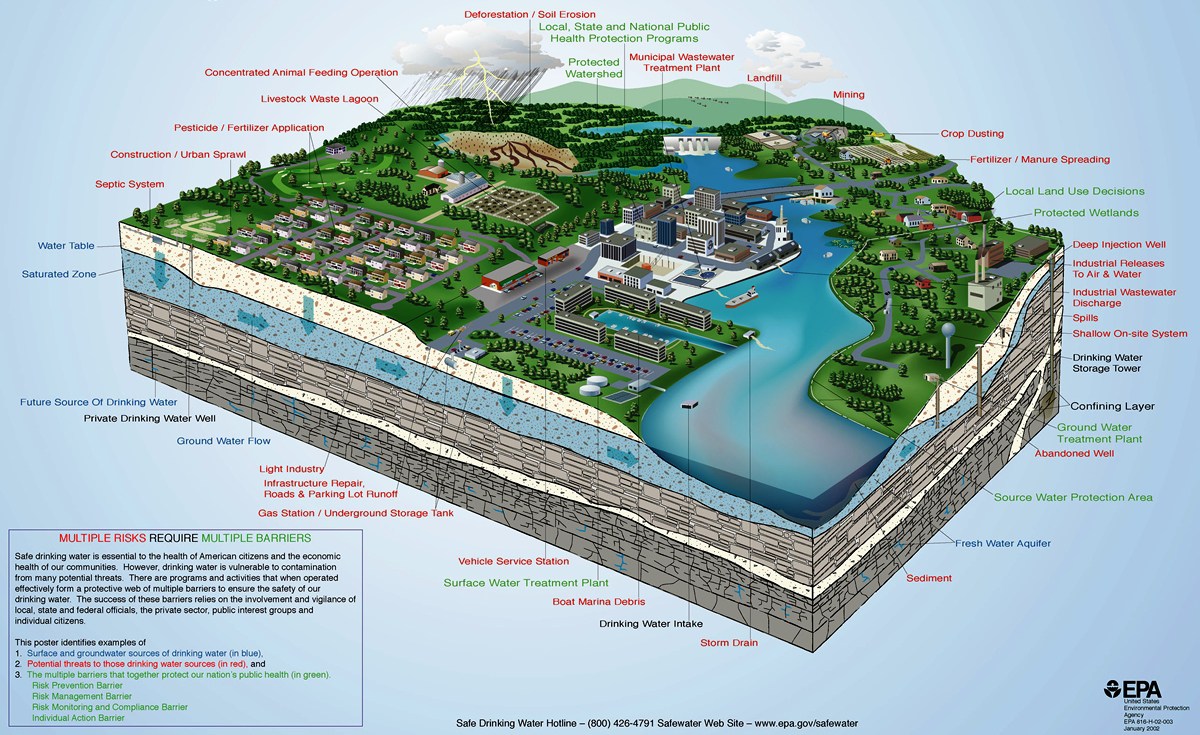A protected drinking water source, combined with proper water quality monitoring, treatment, maintenance and distribution, is necessary to provide clean, safe water.
Source Protection
How does MVD protect the water sources?
MVD participates in the NH Department of Environmental Services (NHDES) Drinking Water Source Protection Program to ensure the water sources remain safe. Each of the wells have an established “Sanitary Protective Radius” (SPR); a radius around the well that is required by law to be controlled by MVD through ownership or easements. In addition to the SPR, MVD’s wells also have an established “Wellhead Protection Area” (WHPA) as delineated by the NHDES. Having the SPR and WHPA allows MVD to monitor, regulate, and prevent any activities that could potentially be harmful to wells and the water they produce. The diagram below, from the United States Environmental Protection Agency (US EPA), reflects examples water sources, potential threats and source protection.
opens in a new windowUS EPA DIAGRAM OF WATER SOURCES, POTENTIAL THREATS, AND PROTECTION* (click to enlarge)
(click to enlarge)
*This diagram is for demonstration purposes only. The area depicted in the image is not located within MVD’s water service area.
How can property owner assist with source protection?
Check out the information below and visit the US EPA’s “Preventing Contamination of Drinking Water Resources” and the NHDES Drinking Water Source Protection Program webpages.
Wintertime Snow & Ice Management
Sodium & Chloride Reduction Program
Easy steps to help protect drinking water.
-
Reduce the amount of trash you create by taking advantage of recycling programs
-
Recycle used antifreeze & motor oil
-
Don’t dump anything into storm drains
-
Do not overuse household chemicals
-
Check frequently for leaks in any underground fuel storage tanks
-
Inspect your septic system for issues yearly
-
Properly seal abandoned wells
-
Limit the use of lawn fertilizers, be sure to use only phosphorus-free lawn fertilizers and reduce or eliminate pesticide applications
-
Keep pollutants away from boat marinas and waterways
-
Report any spills or illegal dumping in especially in designated Drinking Water Protection Areas
Hazardous Household Waste
What are hazardous household wastes?
They are substances that may be harmful to you, animals or the environment when not handled properly. They can be in the form of a solid, liquid or gas and can result in the pollution of groundwater, lakes, rivers, and soil when disposed of improperly.
When it comes to protecting our groundwater, we would do well to remember Ben Franklin’s sage advice: “An ounce of prevention is worth a pound of cure”. Without realizing it, homeowners can become contributors to the contamination of their drinking water. Fertilizers, pesticides, paint thinners, and engine oils are all examples of possible contaminants that can enter groundwater right from your own backyard.
What You Should Do?
To protect yourself, your family and the environment, follow these three steps.
1. Buy Products Wisely
-
Read the label and buy non-toxic alternatives or less toxic products.
-
Buy only what you need for the job to avoid leftover product.
2. When you do buy hazardous products, store them safely.
-
Close lids tightly so products will not dry out, evaporate or leak. Store products in cool, dry area away from sources of heat, spark or flame.
-
Store products in original container with label intact.
-
Separate flammables, corrosives, and poisons; store them on separate shelves.
-
If a container is deteriorating, place the entire container in resealable glass or plastic container, surrounded with non-flammable absorbent, such as cat litter or vermiculite and bring it to your local household hazardous waste collection event.
3. Use Products Safely
-
Read the label carefully before use and follow directions.
-
Use only the recommended amount.
-
Never mix products.
-
Use products in well ventilated rooms and avoid breathing fumes.


